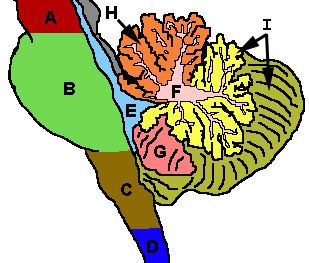Latin arbor vitae cerebelli NeuroLex ID Arbor Vitae TA A14.1.07.401 | NeuroNames hier-689 Dorlands/Elsevier a_56/12149382 FMA 72541 | |
 | ||
The arbor vitae /ˌɑːrbɔːr ˈvaɪtiː/ (Latin for "tree of life") is the cerebellar white matter, so called for its branched, tree-like appearance. In some ways it more resembles a fern and is present in both cerebellar hemispheres. It brings sensory and motor information to and from the cerebellum. The arbor vitae is located deep in the cerebellum. Situated within the arbor vitae are the deep cerebellar nuclei; the dentate, globose, emboliform and the fastigial nuclei. These four different structures lead to the efferent projections of the cerebellum.
The arbor vitae is subject to pathologies such as a cerebellar hemorrhage. Cerebellar hemorrhages arise from tumors, trauma and arteriovenous malformations among other things. The cells in the arbor vitae could also be infected by pathogens which might cause lasting damage, this in turn could lead to cerebellar ataxia.
Related
Godfrey Blount's 1899 book Arbor Vitae was ‘a book on the nature and development of imaginative design for the use of teachers and craftsmen’.
